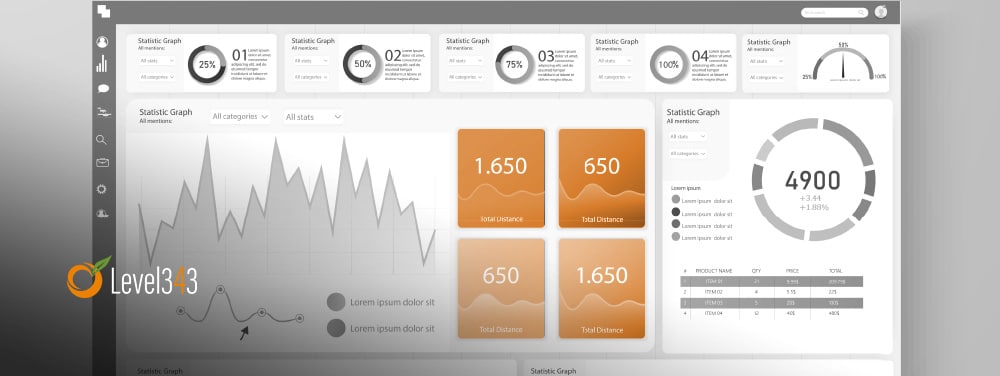Estimated reading time: 11 minutes
Editor’s Note:
This article was Updated May 2022 to ensure quality and updated to be more current.
What is a KPI in marketing? What’s the difference between a good key performance indicator (KPI) and a bad one? How can a metric be good one time and bad the next? What are some examples? –And what do KPIs really do, anyway? We’ll cover this and more today.
What is a KPI in Marketing?
I’m of a firm mind that, if you’re going to really understand a sentence, title or word, you have to break it down into its various parts. That philosophy has served me well enough that I’ve learned five languages in the course of my life time.
It isn’t any different trying to understand a concept – and I’ve found that it helps to gather a deeper understanding of a concept you may have thought you already knew. A “freelancer”, for example, used to be a mercenary that used a lance. Puts a whole new spin on freelancing being a cut-throat world, doesn’t it?
At any rate, I think a good way to start today’s post is to break the term “Key Performance Indicator” into its separate parts to really understand what one is before getting into the more in depth areas.
- Key = Crucial, Critical, Central, Important, Significant – If something is “key” to something else, it is a critical, important or significant part. Good tequila, for example, is key to a good margarita. Otherwise it’s just salty lime juice.
- Performance = Implementation, Fulfillment, Execution, Completion – In this instance, “performance” means the implementation of something.
- Indicator = Measure, Gauge, Guide, Mark, Signal – So, an “indicator” measures or signals something.
Putting them all together then, a KPI is an important signal of how well something is being implemented.
What is KPI Used for?
Everybody wants their clever posts to go viral, or for their website to become the next big thing. However, those goals are difficult to achieve because they lack definition. Before you “go viral”, for example, you need to know what that really means to you and your business. This is why having KPIs in your marketing strategy is not only extremely important, but also extremely effective.
Much like in any part of business, key performance indicators are the measuring metrics of your marketing campaigns; they indicate sales growth, improvement in site traffic, or a rise in click through rate, among others. They are the indicators of success or failure for any area of business or marketing you can think of.
These indicators give you and your team a concrete way to actually quantify your online business’ progress. Instead of dreaming up a goal that’s lofty and undefined, you can point to specific figures and monitor changes over time in certain areas to better direct your marketing efforts.
Not only that, but they also help you and your search marketing team speak the same language. They define specific goals that your marketing or sales team can point to and say, “Yes, we’ve reached those,” or “No, we have more work to do.”
KPIs set expectations, qualify the most important values to the marketing team, and quantify the growth needed for success.
5 Questions to Ask About Your Key Performance Indicators
Have you ever looked at your KPIs and wondered if maybe you were tracking the wrong thing? Do you have the right metrics? Are you looking at the right things? Here are five questions to ask yourself:
Does my KPI clearly define my goal?
If you have to explain a KPI, it’s wrong. Your main KPI, the big number one, the head honcho, shouldn’t be any more difficult than: Goal = KPI
Do my supporting KPIs show what’s really important?
If you’re tracking something that has no relevance to your main goal, it’s a time waster and unimportant. For example, if you’re trying to increase the number of return visitors, it’s a time waster to report on the percentage of new visitors. Why? Because you should already be tracking the percentage and number of return visitors, so you’d basically be tracking the same metric again.
Do I have too many KPIs?
I love benchmarks. I love metrics. However, I also know that there can be such a thing as too much. Too many benchmarks; too much data; too much. Look at your KPIs with an unbiased eye. Do you really need all of them? Are there any that are redundant or useless for the current goal?
Are my KPIs only there to support the facts I want to see?
This is harder. You have to be honest with yourself and with your data. Don’t track just the good stuff. For example, if you’re trying to increase your online sales, don’t just look at traffic or at the number of conversions. You also want to look at the value of those conversions. You want to look at revenue. Higher traffic does not necessarily mean higher revenue.
Is my KPI SMART-compliant?
SMART is an acronym. It means:
- Specific as possible
- Measurable components
- Achievable goals
- Relevant performance increases
- Time-phased
Good VS Bad Key Performance Indicators
What’s the difference between a good and bad KPI? Quite simply, it’s the same answer as with optimization: relevance. This is why pageviews can be a good performance indicator in one instance, but a bad indicator in another. If you want to entice new visitors, knowing your new visitor count is important. If you’re trying to retain visitors, it’s much less so.
Knowing what your goal is will help you figure out what you need to track, and your KPIs are what are relevant to those goals and tracking needs. Don’t just arbitrarily dismiss a metric because it wasn’t viable the last time. Be as flexible as your goals are.
The best key performance indicator answers the question, “What is really important to me in the long-term?” It shows the goal of whatever endeavor you’re trying to complete.
For example, if your long term goal is to double the number of reservations on your hotel site, the number of reservations had better be your main KPI. Everything else goes to support that goal. Any other KPI needs to point towards how well your implementation of that main goal is going.
Does your top KPI do that? If not, it’s time to re-evaluate your tracking metrics.
Learn how KPIs funnel into ROI in digital marketing.
How To Set KPIs for Better Campaign Performance
KPIs can be used to track as wide as the success of your entire business to something as detailed as how well a single landing page is performing. There is a KPI to match any pain point or effort you’re trying to resolve.
In and of themselves, key performance indicators won’t bring success to your company. However, they do help funnel that success, in that they’re the guides that define that all important question: What next?
How a KPI Works in Online Marketing Campaigns
There are a number of pain points–target goals–in an online marketing campaign. Ranking in the search engines, increase website traffic and getting a higher number of leads are just a few.
Each KPI address a different pain point with absolute specificity.
For example, instead of “I want qualified leads,” the KPIs says, “I want to double our qualified leads in 6 months from the website.”
Notice how specific the information is:
- The quantity: double
- The target: qualified leads
- The time frame: 6 months
- The marketing channel: website
The level of detail is important because this is the KPI. It’s the goal for the next marketing campaign, as well as how the success of that campaign will be tracked.
7 Basic Marketing KPI Examples to Watch
There are a number of valuable KPIs, but the most important ones are going to what your company and team customize and deems of value. Customer acquisition, conversions, and social sharing are the ones that jump out when talking to new clients. Without these numbers, there’s no accountability for what your customers are doing on your site or if you’re making an impact on your users, if any at all.
Basic marketing KPIs can give you information and a good starting point for calculating more complicated KPIs, so always keep an eye on these indicators:
1. Conversion Rates
Your marketing efforts are converting clickers into leads, but how many? Can you tell which new leads came from Facebook, Twitter, or Google search? Knowing the rate of conversion for your ads can help you move marketing money to the most effective outlets.
Extra:
Here are a few articles on how to set up your conversion rates via Google Analytics.
2. Customer Acquisition
How many new customers are you actually capturing from your efforts? Clicks and converted leads are a good step, but if they never turn into purchases, there’s no real value in the lead generation source. Figure out where your customers are coming from and you’ll improve your bottom line.
Extra: Read the ultimate customer acquisitions guide from Hubspot.
3. Repeat Customers
Repeat customers mean that you did something right the first time, so congrats are in order. Now determine what percentage of your customers come back for more and you’ll know if you need to tweak customer retention efforts.
Extra: Read about 11 customer retention tools from Bootstrapping Ecommerce.
4. Social Sharing
Short of a referral, there’s nothing better than social sharing. Your current customers can tell other people how great your products are with just a click of a button. Keep track of which networks get the most shares and adjust your social media presence accordingly.
Extra: Sprout Social shares 10 social media analytics tools and some information on each.
5. Mobile Leads
How’s your mobile site doing? Track your mobile customers in the same way you track your main site’s customers and find out.
Extra: Practical E commerce has 11 mobile apps for customer management and lead generation.
6. Page Views
It sounds pretty basic. After all, page views have been monitored since the Internet was in its infancy. Page views are still an important metric, telling you just how many people are looking at your site. With that data, you can compare new customers, repeat customers and other KPIs to come up with all sorts of information.
7. Sales Revenue
Like page views, sales revenue is a basic metric that you should be tracking closely. Knowing how much money you’re making from your website is vital to determining how to pilot your online marketing plan.
Once you’ve got a handle on your basic KPIs, you can then tweak and calculate results with short and long term goals. You can create a scalable content campaign based on proven formulas that work directly with your audience. That’s why it’s imperative you understand what parameters you value. What will speak of your brand, while creating a community.
Advanced KPIS Can Help Your Business Grow
So, your basic KPIs are in line with your goals — customers are converting, sharing and you feel that your marketing dollars are well spent. Good for you. The next step is figuring out how to further grow your business using the same type of tools.
With a closer look at the numbers you’re already generating, it may become obvious where your marketing still needs improvement. There are countless KPIs that fall under this category, but you should definitely not forget these:
8. Cost Per Lead
Knowing how many leads you’ve generated makes it simple to calculate what each one costs. If you’re spending more on generating a lead than they’ll likely spend at your site, it’s time to reconsider your marketing.
Extra: There are so many great articles on this topic I wouldn’t know where to start sharing. I think it’s important to first share this article about the definition of a lead.
9. Customer Lifetime Value
Once you’ve had a few sales, you can start calculating this metric. Take the average customer sale amount, multiply by the average number of purchases per customer per year, then multiply all that by your average retention time in years.
Extra: Learn how to identify your most valuable customers from American Express.
10. Return on Investment
Everybody’s interested in their ROI, even if they don’t know it. Figure out how much you’re making off the new marketing campaign and compare it to what you’re spending for it to determine your ROI.
Extra: I could write a whole new article with all the information on this one topic, but I’ll share this article about marketing ROI tools from WebFX.
11. Search Performance
How well your site is performing on Google is important whether you’re using traditional SEO or going for a more organic approach. High rankings for your targeted keywords means more views that might turn into traffic.
Extra: Find out about 27 tools you can use to help you enhance your search performance.
12. Traffic to Lead Ratio
If you’re already tracking traffic and lead numbers, it’s a breeze to compare your traffic to the number of those same people who actually convert to leads. A higher number of conversions means you’re targeting the right group of people.
Extra: Aside from the obvious Google Analytics there’s a great list of media monitoring tools.
13. Lead to Customer Ratio
Just like traffic to lead ratios, it’s important to figure out how many of those good leads are actually becoming customers. If your leads aren’t turning into customers at a high enough rate, you need to look at your content more closely.
14. Time Spent Engaged
This one is related to your lead to customer ratio. In fact, it’s safe to say that there’s a direct correlation. The longer leads spend on your site, the more engaged they are and the more likely they are to turn into customers. Engagement is everything when it comes to turning a customer into a sale.
Conclusion
“What can be measured can be managed,” says Peter Druker. –But I’m also a fan of, “Just because it can be measured, doesn’t mean it should be.” While building your goals, deciding your metrics and setting your benchmarks, don’t get buried under useless data. KPIs only help if they are useful in the improvement of your processes, and if those implemented processes are useful to reach your goal.
There are plenty of KPIs to chase out there on the web, but it’s a good idea not to have so many that you’re overwhelmed. Don’t over-focus on those KPIs you’re tracking, instead use them to gently pilot your marketing plan. With careful structure, specific goals and fine-tuned marketing campaigns, your largest KPI will grow: the success of your company.
How well are your marketing campaigns doing? If you’re struggling, reach out to a company with almost two decades of experience in targeting and reaching the right KPI goals. Learn about our marketing and SEO services, or contact us to discuss your project.
Updated May 2022 to ensure quality



































